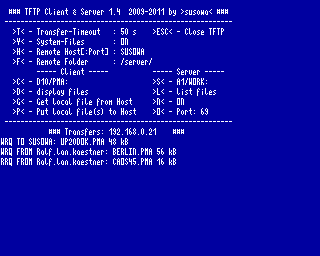- Details
- Geschrieben von Super User
- Hauptkategorie: Magazines
- Kategorie: CFOG's PIP
- Veröffentlicht: 30. November 1987
- Zugriffe: 28768
CFOG's PIP, July 1987, Volume 5 No. 9, Whole No. 57, page 1
Adding the Advent TurboROM to a Kaypro 10
by Benjamin H. Cohen
I recently acquired a Kaypro 10 to add to my stable of Osbornes. I had heard through the grapevine that the Advent TurboROM was a big improvement over the Kaypro furnished ROM which has been described as a 'dinosaur'. I got the 10 on a Saturday and ordered the TurboROM the following Monday.
Installation was easy. If I had eight fewer thumbs and was comfortable soldering wires on computer boards it would have been cheaper. For certain models you need either to order a $9.95 kit from Advent or solder a wire. For other models the kit has other parts. In any event, I ordered the kit. The removal of the main chip was simpIe. The adapter wire slips over one leg of the replacement chip and hooks onto a leg of another chip. The manual and instructions are generally excellent but didn't tell that you simply squeeze the two ends of the plastic thig-a-mabob attached at one end of the wire to expose the hook, stick it on the indicated leg of the chip, then release and let the spring inside hold on.
Before you do this you read essentially the entire manual. I really mean that. If you don't read the manual first you'll find you're in a real pickle. You must, among other things, make a couple of disks up before you install the TR. If you haven't you'll have problems. One of the disks is the boot disk for the TR. The other is a boot disk to reboot your system with the old ROM if you should ever be so misguided as to remove the TR and put the old one back in.
I haven't explored all of the features of the TR yet, but there are enough to make my $69.90 ($59.95 for the TR, $9.95 for the adapter kit) a real bargain.
- My hard disk has been reformatted with the Advent 512 byte sector format. From about 8.9 megabytes my disk capacity has jumped to 10.3 Mb. Advent also provides a 1024 byte sector format, but some older drives won't format to that. If you have a newer drive you'll probably be able to use it you'll get a 11 Mb disk.
- ZCPR1 is resident in the new system. I've mentioned this before for Osborne owners. If you're still using vanilla-CP/M 2.2 you ought to get ZCPR1 at the very least. It has three important features: (a) echo of names of erased files, that is, whenever you erase a file or a bunch of files, even using wild cards, a list of the erased files is put on the screen so you can unerases the one you really didn't want to erase but forgot were there and met the argument of the command; (b) automatic search to drive A: for commands not found on the logged drive; and (c) the intrinsic "go" command to rerun the last transient file used from memory without the need to get it from the disk again.
- Several disk formats are read as 'native', most importantly for me, Osborne SSDD format. This means I can work on files on the Kaypro, stick an Osborne disk in the floppy drive, do a warm boot (hit ^C), run NSWP or any other program that I want to copy the tile to the Osborne disk, and continue. Until I stick a different format disk in the floppy drive and do a warm boot the Kaypro will expect to find Osborne SSDD disks there. Since I have a lot of Osbornes around at home and in my law office, this is a great convenience.
- Disk drive read/write speed is greatly increased. I didn't make any timed tests before installing the TR, but the time for disk reads and writes is clearly less than half what it used to be. It's a matter of perception, since I have not timed it, but I still think the Trantor on my office Executive is faster. But I now perceive it as faster than an Executive with two floppies only (I didn't before).
When I got my Drive C: RAM disk someone told me that in general if you got a RAM disk first you would like it more than a hard disk but that if you got a hard disk first you'd like it more than a RAM disk. I'm not sure that's correct. The simple fact is that RAM disks are different than hard disks. If you need [or crave] sheer speed and generally work with a limited number of programs and data files, then a RAM disk is probably what you want. If it's more important that you have at your fingertips every application and utility program you might want at any time this month, or if you work with many different files during the course of a single computing session, then a hard disk will have many attractions to you. It's faster than floppies, but nowhere near as fast as a RAM disk.
The best of all possible worlds, of course, is to combine the benefits of both RAM disk and hard disk. I'm looking forward to justifying the purchase of the High Tech Research Ultra Board (see separate article in this issue of PIP) to add to my Kaypro 10. Maybe then I'll be as happy as Kevin Murphy! (See Kevin's article about his Kaypro 2X also in this issue!)
- Zurück
- Weiter >>




